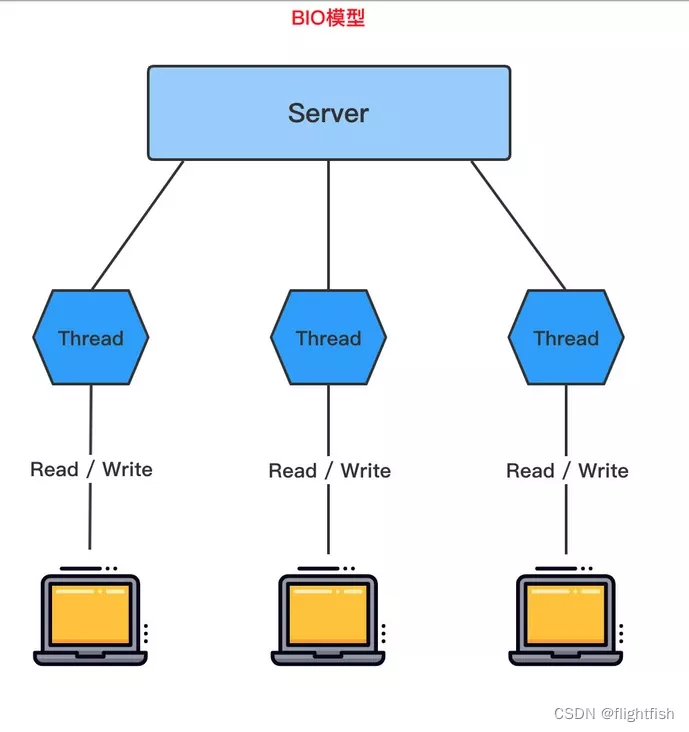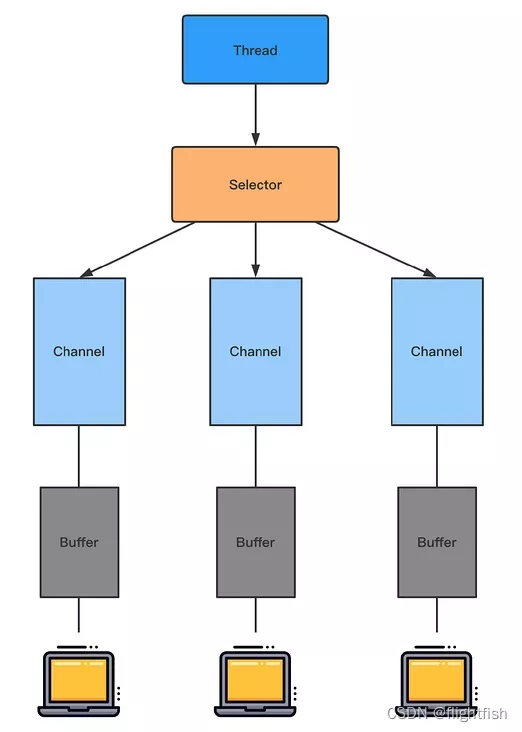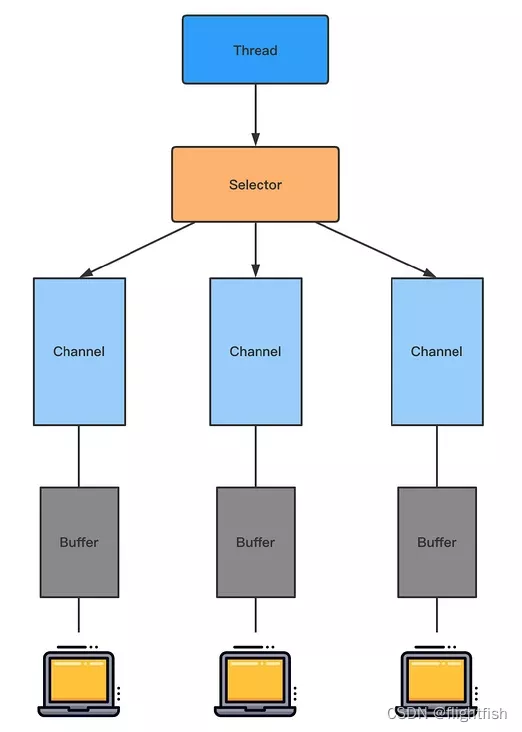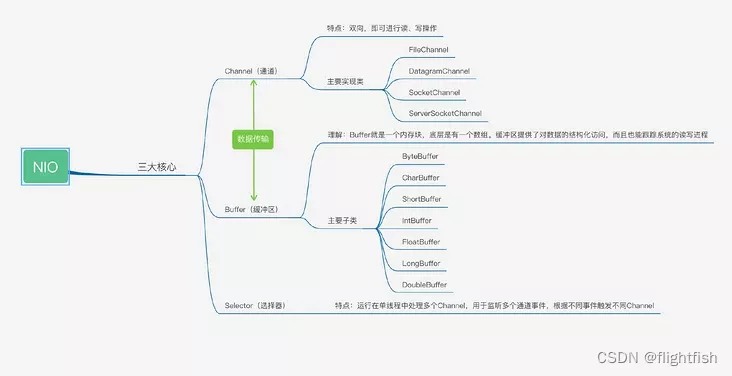I/O 模型
I/O 模型基本说明
-
I/O 模型简单理解为:就是使用什么样的通道进行数据的发送和接收,很大程度上决定了程序通信的性能。
-
Java 支持 3 种网络编程模型:BIO、NIO、AIO。
Java BIO:
同步并阻塞(传统阻塞型),服务器实现模式为一个连接一个线程,即客户端有连接请求时服务器端就需要启动一个线程进行处理,如果这个连接不作任何事情会造成不必要的线程开销。
Java NIO:同步非阻塞,服务器实现模式为一个线程处理多个请求(连接),即客户端发送的连接请求会被注册到多路复用器上,多路复用器轮询到有 I/O 请求就会进行处理。
Java AIO:异步非阻塞,AIO 引入了异步通道的概念,采用了 Proactor 模式,简化了程序编写,有效的请求才启动线程,它的特点是先由操作系统完成后才通知服务端程序启动线程去处理,一般适用于连接数较多且连接时间较长的应用。
同步阻塞:你到饭馆点餐,然后在那等着,还要一边喊:好了没啊!同步非阻塞:在饭馆点完餐,就去遛狗了。不过溜一会儿,就回饭馆喊一声:好了没啊!异步阻塞:遛狗的时候,接到饭馆电话,说饭做好了,让您亲自去拿。异步非阻塞:饭馆打电话说,我们知道您的位置,一会给你送过来,安心遛狗就可以了。
BIO、NIO、AIO 使用场景分析
- BIO 方式适用于
连接数比较小且固定的架构,这种方式对服务器资源要求比较高,并发局限于应用中,JDK1.4 之前唯一的选择,程序较为简单容易理解。 - NIO 方式适用于
连接数目多且连接比较短的架构,比如聊天服务器,弹幕系统,服务器间通讯等,编程比较复杂,JDK1.4 开始支持。 - AIO 方式适用于
连接数目多且连接比较长的架构,比如相册服务器,充分调用 OS 参与并发操作,变成比较复杂,JDK7 开始支持。
BIO 基本介绍
- Java BIO 就是传统的 Java IO 编程,其相关的类和接口在 java.io 包下。
- BIO(Blocking I/O):
同步阻塞,服务器实现模式为一个连接一个线程,即客户端有连接请求时,服务器就会需要启动一个线程来进行处理。如果这个连接不作任何事情就会造成不必要的开销,可以通过线程池机制改善。
BIO 编程简要流程
- 服务器驱动一个 ServerSocket。
- 客户端启动 Socket 对服务器进行通信,默认情况下服务器端需要对每一个客户端建立一个线程进行通信。
- 客户端发出请求后,先咨询服务器时候否线程响应,如果没有则会等待,或者被拒绝。
- 如果有响应,客户端线程会等待请求结束后,再继续执行。
BIO 服务端代码案例
public class Server {
public static void main(String[] args) throws IOException {
//创建线程池
ExecutorService executorService = Executors.newCachedThreadPool();
//创建serverSocket
ServerSocket serverSocket = new ServerSocket(6666);
for (; ; ) {
System.out.println("等待连接中...");
//监听,等待客户端连接
Socket socket = serverSocket.accept();
System.out.println("连接到一个客户端");
executorService.execute(() -> handler(socket));
}
}
//编写一个handler方法,和客户端通讯
public static void handler(Socket socket) {
byte[] bytes = new byte[1024];
System.out.println("当前线程信息: " + Thread.currentThread().getName());
try {
//通过socket获取输入流
InputStream inputStream = socket.getInputStream();
//循环读取客户端发送的数据
while (inputStream.read(bytes) != -1) {
System.out.println(Thread.currentThread().getName()+ " : 发送信息为 :"+ new String(bytes, 0, bytes.length));
}
} catch (IOException e) {
e.printStackTrace();
} finally {
System.out.println("关闭连接");
try {
socket.close();
} catch (IOException e) {
e.printStackTrace();
}
}
}
}
运行结果
使用终端命令
telnet 127.0.0.1 6666
[外链图片转存失败,源站可能有防盗链机制,建议将图片保存下来直接上传(img-DNOvs15E-1656935549536)(https://segmentfault.com/img/remote/1460000037714811)]
BIO 问题分析
- 每个请求都需要创建独立的线程,与对应的客户端进行数据处理。
- 当并发数大时,需要
创建大量线程来处理连接,系统资源占用较大。 - 连接建立后,如果当前线程暂时没有数据可读,则当前线程会一直阻塞在 Read 操作上,造成线程资源浪费。
NIO 基本介绍
- Java NIO 全称 Java non-blocking IO,指的是 JDK 提供的新 API。从 JDK 1.4 开始,Java 提供了一系列改进的输入/输出的新特性,被统称为 NIO,即 New IO,是
同步非阻塞的。 - NIO 相关类都放在 java.nio 包下,并对原 java.io 包中很多类进行了改写。
- NIO 有三大核心部分:
Channel(管道)、Buffer(缓冲区)、Selector(选择器)。 - NIO 是面向
缓冲区编程的。数据读取到了一个它稍微处理的缓冲区,需要时可在缓冲区中前后移动,这就增加了处理过程中的灵活性,使用它可以提供非阻塞的高伸缩性网络。 - Java NIO 的非阻塞模式,使一个线程从某通道发送请求读取数据,但是它仅能得到目前可用数据,如果目前没有可用数据时,则说明都不会获取,而不是保持线程阻塞,所以直到数据变为可以读取之前,该线程可以做其他事情。非阻塞写入同理。
NIO Buffer 的基本使用
public class BufferTest {
public static void main(String[] args) {
//同理对应的还有:ByteBuffer,IntBuffer,FloatBuffer,CharBuffer,ShortBuffer,DoubleBuffer,LongBuffer
//创建一个Buffer,大小为5
IntBuffer buffer = IntBuffer.allocate(5);
//存放数据
for (int i = 0; i < buffer.capacity(); i++) {
buffer.put(i);
}
//切换成读模式. 读写切换
buffer.flip();
while (buffer.hasRemaining()) {
System.out.println(buffer.get()); // 0 1 2 3 4
}
}
}
NIO 和 BIO 对比
- BIO 以流的方式处理数据,而 NIO 以块的方式处理数据,块 I/O 的效率比流 I/O 高很多。
- BIO 是阻塞的,而 NIO 是非阻塞的。
- BIO 基于字节流和字符流进行操作,而 NIO 基于 Channel(通道)和 Buffer(缓冲区)进行操作,数据总是从通道读取到缓冲区中,或者从缓冲区写入到通道中。Selector(选择器)用于监听多个通道事件(比如连接请求,数据到达等),因此
使用单个线程就可以监听多个客户端通道。
NIO 三大核心组件关系
说明:
- 每个 Channel 对应一个 Buffer。
- Selector 对应一个线程,一个线程对应多个 Channel。
- 该图反应了有三个 Channel 注册到该 Selector。
- 程序切换到那个 Channel 是由
事件决定的(Event)。 - Selector 会根据不同的事件,在各个通道上切换。
- Buffer 就是一个内存块,底层是有一个数组。
- 数据的读取和写入是通过 Buffer,但是需要
flip()切换读写模式。而 BIO 是单向的,要么输入流要么输出流。
NIO 三大核心理解
Buffer 的机制及子类
Buffer(缓冲区)基本介绍
缓冲区本质上是一个可以读写数据的内存块,可以理解为是一个容器对象(含数组),该对象提供了一组方法,可以更轻松地使用内存块,缓冲区对象内置了一些机制,能够跟踪和记录缓冲区的状态变化情况。
Channel 提供从文件、网络读取数据的渠道,但是读取或者都必须经过 Buffer。
在 Buffer 子类中维护着一个对应类型的数组,用来存放数据:
public abstract class IntBuffer
extends Buffer
implements Comparable<IntBuffer>
{
// These fields are declared here rather than in Heap-X-Buffer in order to
// reduce the number of virtual method invocations needed to access these
// values, which is especially costly when coding small buffers.
//
final int[] hb; // Non-null only for heap buffers
final int offset;
boolean isReadOnly; // Valid only for heap buffers
// Creates a new buffer with the given mark, position, limit, capacity,
// backing array, and array offset
//
IntBuffer(int mark, int pos, int lim, int cap, // package-private
int[] hb, int offset)
{
super(mark, pos, lim, cap);
this.hb = hb;
this.offset = offset;
}
// Creates a new buffer with the given mark, position, limit, and capacity
//
IntBuffer(int mark, int pos, int lim, int cap) { // package-private
this(mark, pos, lim, cap, null, 0);
}
| Buffer 常用子类 | 描述 |
|---|---|
| ByteBuffer | 存储字节数据到缓冲区 |
| ShortBuffer | 存储字符串数据到缓冲区 |
| CharBuffer | 存储字符数据到缓冲区 |
| IntBuffer | 存储整数数据据到缓冲区 |
| LongBuffer | 存储长整型数据到缓冲区 |
| DoubleBuffer | 存储浮点型数据到缓冲区 |
| FloatBuffer | 存储浮点型数据到缓冲区 |
Buffer 中定义了四个属性来提供所其包含的数据元素。
// Invariants: mark <= position <= limit <= capacity
private int mark = -1;
private int position = 0;
private int limit;
private int capacity;
| 属性 | 描述 |
|---|---|
| capacity | 容量,即可以容纳的最大数据量;在缓冲区被创建时候就被指定,无法修改 |
| limit | 表示缓冲区的当前终点,不能对缓冲区超过极限的位置进行读写操作,但极限是可以修改的 |
| position | 当前位置,下一个要被读或者写的索引,每次读写缓冲区数据都会改变该值,为下次读写做准备 |
| Mark | 标记当前 position 位置,当 reset 后回到标记位置。 |
Channel 的基本介绍
NIO 的通道类似于流,但有如下区别:
- 通道是双向的可以进行读写,而流是单向的只能读,或者写。
- 通道可以实现异步读写数据。
- 通道可以从缓冲区读取数据,也可以写入数据到缓冲区。
常用的 Channel 有:FileChannel、DatagramChannel、SocketChannel、SocketServerChannel。
FileChannel 类
FileChannel 主要用来对本地文件进行 IO 操作,常见的方法有:
- public int read(ByteBuffer dst) :从通道中读取数据到缓冲区中。
- public int write(ByteBuffer src):把缓冲区中的数据写入到通道中。
- public long transferFrom(ReadableByteChannel src,long position,long count):从目标通道中复制数据到当前通道。
- public long transferTo(long position,long count,WriteableByteChannel target):把数据从当前通道复制给目标通道。
使用 FileChannel 写入文本文件
public class NIOFileChannel {
public static void main(String[] args) throws IOException {
String str = "Hello,Java菜鸟程序员";
//创建一个输出流
FileOutputStream fileOutputStream = new FileOutputStream("hello.txt");
//获取通道
FileChannel channel = fileOutputStream.getChannel();
//创建缓冲区
ByteBuffer byteBuffer = ByteBuffer.allocate(100);
//写入byteBuffer
byteBuffer.put(str.getBytes());
//切换模式
byteBuffer.flip();
//写入通道
channel.write(byteBuffer);
//关闭
channel.close();
fileOutputStream.close();
}
}
使用 FileChannel 读取文本文件
public class NIOFileChannel {
public static void main(String[] args) throws IOException {
FileInputStream fileInputStream = new FileInputStream("hello.txt");
FileChannel channel = fileInputStream.getChannel();
ByteBuffer byteBuffer = ByteBuffer.allocate(100);
channel.read(byteBuffer);
System.out.println(new String(byteBuffer.array(), 0, byteBuffer.limit())); //Hello,Java菜鸟程序员
channel.close();
fileInputStream.close();
}
}
使用 FileChannel 复制文件
public class NIOFileChannel03 {
public static void main(String[] args) throws IOException {
FileInputStream fileInputStream = new FileInputStream("hello.txt");
FileOutputStream fileOutputStream = new FileOutputStream("world.txt");
FileChannel inChannel = fileInputStream.getChannel();
FileChannel outChannel = fileOutputStream.getChannel();
ByteBuffer byteBuffer = ByteBuffer.allocate(1);
while (inChannel.read(byteBuffer) != -1) {
byteBuffer.flip();
outChannel.write(byteBuffer);
//清空重置
byteBuffer.clear();
}
fileOutputStream.close();
fileInputStream.close();
}
}
使用 transferFrom 复制文件
public class NIOFileChannel04 {
public static void main(String[] args) throws IOException {
FileInputStream fileInputStream = new FileInputStream("hello.txt");
FileOutputStream fileOutputStream = new FileOutputStream("world.txt");
FileChannel inChannel = fileInputStream.getChannel();
FileChannel outChannel = fileOutputStream.getChannel();
//从哪拷贝,从几开始到几结束 对应的还有transferTo()方法.
outChannel.transferFrom(inChannel, 0, inChannel.size());
outChannel.close();
inChannel.close();
fileOutputStream.close();
fileInputStream.close();
}
}
Channel 和 Buffer 的注意事项
- ByteBuffer 支持类型化的 put 和 get,put 放入什么数据类型,get 就应该使用相应的数据类型来取出,否则可能会产生 ByteUnderflowException 异常。
- 可以将一个普通的 Buffer 转换为只读的 Buffer:asReadOnlyBuffer()方法。
- NIO 提供了 MapperByteBuffer,可以让文件直接在**内存(堆外内存)**中进行修改,而如何同步到文件由 NIO 来完成。
- NIO 还支持通过多个 Buffer(即 Buffer 数组)完成读写操作,即Scattering(分散)和 Gathering(聚集)。
Scattering(分散):在向缓冲区写入数据时,可以使用 Buffer 数组依次写入,一个 Buffer 数组写满后,继续写入下一个 Buffer 数组。Gathering(聚集):从缓冲区读取数据时,可以依次读取,读完一个 Buffer 再按顺序读取下一个。
Selector 的基本介绍
- Java 的 NIO 使用了非阻塞的 I/O 方式。可以用一个线程处理若干个客户端连接,就会使用到 Selector(选择器)。
- Selector 能够检测到多个注册通道上是否有事件发生(多个 Channel 以事件的形式注册到同一个 selector),如果有事件发生,便获取事件然后针对每个事件进行相应的处理。
- 只有在连接真正有读写事件发生时,才会进行读写,减少了系统开销,并且不必为每个连接都创建一个线程,不用维护多个线程。
- 避免了多线程之间上下文切换导致的开销。
Selector 特点
Netty 的 I/O 线程 NioEventLoop 聚合了 Selector(选择器 / 多路复用器),可以并发处理成百上千个客户端连接。
当线程从某客户端 Socket 通道进行读写时,若没有数据可用,该线程可以进行其他任务。
线程通常将非阻塞 I/O 的空闲时间用于其他通道上执行 I/O 操作,所以单独的线程可以管理多个输入输出通道。
由于读写操作都是非阻塞的,就可以充分提高 I/O 线程的运行效率,避免由于频繁 I/O 阻塞导致的线程挂起。
一个 I/O 线程可以并发处理 N 个客户端连接和读写操作,这从根本上解决了传统同步阻塞 I/O 一连接一线程模型,架构性能、弹性伸缩能力和可靠性都得到极大地提升。
Selector 常用方法
public abstract class Selector implement Closeable{
public static Selector open(); //得到一个选择器对象
public int select(long timeout); //监控所有注册的通道,当其中的IO操作可以进行时,将对应的selectionkey加入内部集合并返回,参数设置超时时间
public Set<SelectionKey> selectionKeys(); //从内部集合中得到所有的SelectionKey
}
Selector 相关方法说明
selector.select()://若未监听到注册管道中有事件,则持续阻塞selector.select(1000)://阻塞 1000 毫秒,1000 毫秒后返回selector.wakeup()://唤醒 selectorselector.selectNow(): //不阻塞,立即返回
NIO 非阻塞网络编程过程分析
- 当客户端连接时,会通过 SeverSocketChannel 得到对应的 SocketChannel。
- Selector 进行监听,调用 select()方法,返回注册该 Selector 的所有通道中有事件发生的通道个数。
- 将 socketChannel 注册到 Selector 上,public final SelectionKey register(Selector sel, int ops),一个 selector 上可以注册多个 SocketChannel。
- 注册后返回一个 SelectionKey,会和该 Selector 关联(以集合的形式)。
- 进一步得到各个 SelectionKey,有事件发生。
- 再通过 SelectionKey 反向获取 SocketChannel,使用 channnel()方法。
- 可以通过得到的 channel,完成业务处理。
SelectionKey 中定义了四个操作标志位:
OP_READ表示通道中发生读事件;OP_WRITE—表示通道中发生写事件;OP_CONNECT—表示建立连接;OP_ACCEPT—请求新连接。
NIO 非阻塞网络编程代码示例
public class Server {
public static void main(String[] args) throws IOException {
//创建serverSocketChannel
ServerSocketChannel serverSocketChannel = ServerSocketChannel.open();
//绑定端口
serverSocketChannel.socket().bind(new InetSocketAddress(6666));
//设置为非阻塞
serverSocketChannel.configureBlocking(false);
//得到Selector对象
try (Selector selector = Selector.open()) {
//把ServerSocketChannel注册到selector,事件为OP_ACCEPT
serverSocketChannel.register(selector, SelectionKey.OP_ACCEPT);
//如果返回的>0,表示已经获取到关注的事件
while (selector.select() > 0) {
Set<SelectionKey> selectionKeys = selector.selectedKeys();
Iterator<SelectionKey> iterator = selectionKeys.iterator();
while (iterator.hasNext()) {
//获得到一个事件
SelectionKey next = iterator.next();
//如果是OP_ACCEPT,表示有新的客户端连接
if (next.isAcceptable()) {
//给该客户端生成一个SocketChannel
SocketChannel accept = serverSocketChannel.accept();
accept.configureBlocking(false);
//将当前的socketChannel注册到selector,关注事件为读事件,同时给socket Channel关联一个buffer
accept.register(selector, SelectionKey.OP_READ,ByteBuffer.allocate(1024));
System.out.println("获取到一个客户端连接");
//如果是读事件
} else if (next.isReadable()) {
//通过key 反向获取到对应的channel
SocketChannel channel = (SocketChannel) next.channel();
//获取到该channel关联的buffer
ByteBuffer buffer = (ByteBuffer) next.attachment();
while (channel.read(buffer) != -1) {
buffer.flip();
System.out.println(new String(buffer.array(), 0, buffer.limit()));
buffer.clear();
}
}
iterator.remove();
}
}
}
}
}
public class Client {
public static void main(String[] args) throws IOException {
//得到一个网络通道
SocketChannel socketChannel = SocketChannel.open();
//设置为非阻塞
socketChannel.configureBlocking(false);
//提供服务器端的IP和端口
InetSocketAddress inetSocketAddress = new InetSocketAddress("127.0.0.1", 6666);
//连接服务器
if (!socketChannel.connect(inetSocketAddress)) {
while (!socketChannel.finishConnect()) {
System.out.println("连接需要时间,客户端不会阻塞...先去吃个宵夜");
}
}
//连接成功,发送数据
String str = "hello,Java菜鸟程序员";
ByteBuffer byteBuffer = ByteBuffer.wrap(str.getBytes());
socketChannel.write(byteBuffer);
socketChannel.close();
System.out.println("客户端退出");
}
}
运行结果
[外链图片转存失败,源站可能有防盗链机制,建议将图片保存下来直接上传(img-CCQo3ZO7-1656935549538)(https://segmentfault.com/img/remote/1460000037714812)]
SelectionKey 的相关方法
| 方法 | 描述 |
|---|---|
| public abstract Selector selector(); | 得到与之关联的 Selector 对象 |
| public abstract SelectableChannel channel(); | 得到与之关联的通道 |
| public final Object attachment() | 得到与之关联的共享数据 |
| public abstract SelectionKey interestOps(int ops); | 设置或改变监听的事件类型 |
| public final boolean isReadable(); | 通道是否可读 |
| public final boolean isWritable(); | 通道是否可写 |
| public final boolean isAcceptable(); | 是否可以建立连接 ACCEPT |
NIO 实现群聊系统
- 实现服务器端与客户端的数据简单通讯(非阻塞)实现多人群聊。
- 服务器端:可以检测用户上线,离线,并实现消息转发功能。
- 客户端:通过 Channel 可以无阻塞发送数据给其他所有用户,同时可以接收其他用户发送的消息(由服务器转发得到)。
public class GroupChatClient {
private static final String HOST = "127.0.0.1";
private static final int PORT = 6667;
private Selector selector;
private SocketChannel socketChannel;
private String username;
public GroupChatClient() {
try {
selector = Selector.open();
//连接服务器
socketChannel = SocketChannel.open(new InetSocketAddress(HOST, PORT));
//设置非阻塞
socketChannel.configureBlocking(false);
//注册
socketChannel.register(selector, SelectionKey.OP_READ);
username = socketChannel.getLocalAddress().toString().substring(1);
System.out.println("客户端: " + username + ",准备就绪...");
} catch (IOException e) {
e.printStackTrace();
}
}
/**
* 向服务器发送数据
*
* @param info
*/
public void sendInfo(String info) {
info = username + "说: " + info;
try {
socketChannel.write(ByteBuffer.wrap(info.getBytes()));
} catch (IOException e) {
e.printStackTrace();
}
}
/**
* 读取服务端回复的消息
*/
public void readInfo() {
try {
//有可用通道
if (selector.select() > 0) {
Iterator<SelectionKey> iterator = selector.selectedKeys().iterator();
while (iterator.hasNext()) {
SelectionKey key = iterator.next();
if (key.isReadable()) {
//得到相关的通道
SocketChannel sc = (SocketChannel) key.channel();
//得到一个buffer
ByteBuffer buffer = ByteBuffer.allocate(1024);
//读取
sc.read(buffer);
//把读取到的缓冲区数据转成字符串
String msg = new String(buffer.array());
System.out.println(msg.trim());
}
iterator.remove(); //删除当前的selectionKey,防止重复操作
}
}
} catch (IOException e) {
e.printStackTrace();
}
}
public static void main(String[] args) {
//启动客户端
GroupChatClient chatClient = new GroupChatClient();
//启动一个线程,每隔3秒,读取从服务器端发送的数据
new Thread(() -> {
while (true) {
chatClient.readInfo();
try {
TimeUnit.MILLISECONDS.sleep(500);
} catch (InterruptedException e) {
e.printStackTrace();
}
}
}).start();
//发送数据给服务器
Scanner scanner = new Scanner(System.in);
while (scanner.hasNextLine()) {
chatClient.sendInfo(scanner.nextLine());
}
}
}
public class GroupChatServer {
//定义属性
private Selector selector;
private ServerSocketChannel listenChannel;
private static final int PORT = 6667;
public GroupChatServer() {
try {
//获得选择器
selector = Selector.open();
//listenChannel
listenChannel = ServerSocketChannel.open();
//绑定端口
listenChannel.socket().bind(new InetSocketAddress(PORT));
//设置非阻塞模式
listenChannel.configureBlocking(false);
//将该listenChannel注册到Selector
listenChannel.register(selector, SelectionKey.OP_ACCEPT);
} catch (IOException e) {
e.printStackTrace();
}
}
public static void main(String[] args) {
//创建一个服务器对象
GroupChatServer groupChatServer = new GroupChatServer();
//监听
groupChatServer.listen();
}
/**
* 监听
*/
public void listen() {
try {
//如果返回的>0,表示已经获取到关注的事件
while (selector.select() > 0) {
Iterator<SelectionKey> iterator = selector.selectedKeys().iterator();
//判断是否有事件
while (iterator.hasNext()) {
//获得事件
SelectionKey key = iterator.next();
//如果是OP_ACCEPT,表示有新的客户端连接
if (key.isAcceptable()) {
SocketChannel socketChannel = listenChannel.accept();
//设置为非阻塞
socketChannel.configureBlocking(false);
//注册到Selector
socketChannel.register(selector, SelectionKey.OP_READ);
System.out.println("获取到一个客户端连接 : " + socketChannel.getRemoteAddress() + " 上线!");
} else if (key.isReadable()) {
//如果是读事件,就读取数据
readData(key);
}
iterator.remove();
}
}
} catch (IOException e) {
e.printStackTrace();
} finally {
}
}
/**
* 读取客户端消息
*/
private void readData(SelectionKey key) {
SocketChannel channel = null;
try {
//得到channel
channel = (SocketChannel) key.channel();
//创建buffer
ByteBuffer buffer = ByteBuffer.allocate(1024);
if (channel.read(buffer) != -1) {
String msg = new String(buffer.array());
System.out.println(msg);
// 转发消息给其它客户端(排除自己)
sendInfoOtherClients(msg, channel);
}
} catch (Exception e) {
try {
System.out.println(channel.getRemoteAddress() + " 下线了!");
// 关闭通道
key.cancel();
channel.close();
} catch (IOException ioException) {
ioException.printStackTrace();
}
} finally {
}
}
/**
* 转发消息给其它客户端(排除自己)
*/
private void sendInfoOtherClients(String msg, SocketChannel self) throws IOException {
//服务器转发消息
System.out.println("服务器转发消息中...");
//遍历所有注册到selector的socketChannel并排除自身
for (SelectionKey key : selector.keys()) {
//反向获取通道
Channel targetChannel = key.channel();
//排除自身
if (targetChannel instanceof SocketChannel && targetChannel != self) {
//转型
SocketChannel dest = (SocketChannel) targetChannel;
//将msg存储到buffer中
ByteBuffer buffer = ByteBuffer.wrap(msg.getBytes());
//将buffer中的数据写入通道
dest.write(buffer);
}
}
}
}
AIO 基本介绍
JDK 7 引入了 Asynchronous I/O,即 AIO。在进行 I/O 编程中,通常用到两种模式:Reactor 和 Proactor 。Java 的 NIO 就是 Reactor,当有事件触发时,服务器端得到通知,进行相应的处理。
AIO 叫做异步非阻塞的 I/O,引入了异步通道的概念,采用了 Proactor 模式,简化了程序编写,有效的请求才会启动线程,特点就是先由操作系统完成后才通知服务端程序启动线程去处理,一般用于连接数较多且连接时长较长的应用。
Reactor 与 Proactor
- 两种 IO 多路复用方案:Reactor and Proactor。
- Reactor 模式是基于同步 I/O 的,而 Proactor 模式是和异步 I/O 相关的。
由于 AIO 目前应用并不广泛,所以本文只是讲述 AIO 基本介绍。



